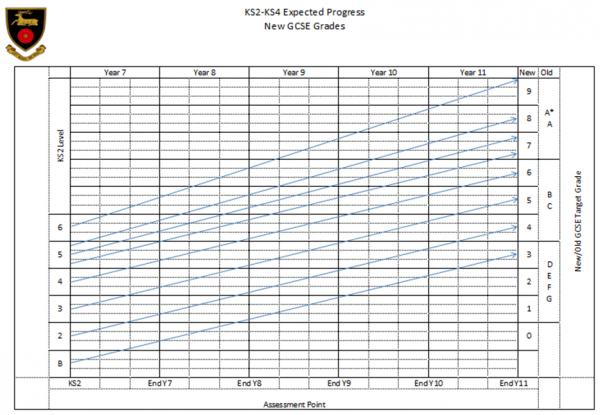In this blog I want to take a look at how these grade descriptors can be utilised from Years 7-11 to provide a clear and coherent flight path for pupils in history.
Using the grade descriptors to create a flight path
Many schools for instance have opted for the following basic flight path:
No problem, I am sure the subject experts can work it out. Let’s see now… what could be done with AO2?
 Look how happy everyone is that this will fit onto a SIMS mark sheet!
Look how happy everyone is that this will fit onto a SIMS mark sheet! Oh! One last thing... for the purposes of tracking we just need to split these down a bit, because moving a Grade a year makes it really hard to show "Progress" TM . The way it is set up doesn’t really give enough resolution. We will need to subdivide this a bit I think. Let’s have a go at the steps between Grade 6 and 7. Because this is decimal system, I think 10 subdivisions would be appropriate, don’t you? That way they should move about 2 points a half term. Just think how well that would track on Excel! We could have boxes that changed colour and everything....

I apologise if I am being overly facetious here, but the number of conversations I have had in recent months about the use of GCSE grade descriptors to replace levels just beggars belief. In the very worst cases, the idea is to use GCSE grades from Year 7 so that pupils can see where they are on a flight path to the end of Year 11. I have talked about the issues with linear progression models at great length before HERE. I also want to ass that this is not really the fault of these descriptors as they have not been designed as a progression model but as a loose description to guide the grading of a TWO YEAR GCSE COURSE as specified in one of a number of accredited specifications. However, I want to pick up on two problems directly related to this model.
Problem 1: Communicating with pupils and parents
Let’s just imagine I have a Year 7 pupil who has come to me on a GCSE Grade 2. What will move her to a Grade 3? Well instantly I note that I have to go to my “made up” steps in between the existing descriptors. But even if I used Grade 5 as the target instead, what would I say? “Make your reasoning less basic and more coherent!”? What would this actually mean? What would I be wanting her to do? And what reasoning? In what? Her studies at Year 7 content, or the study of the Year 10-11 content she has not yet covered? It is deeply unhelpful. There is absolutely nothing in these Grades grounded in curriculum and therefore they are largely useless as a formative measure for assessing curriculum. As a means of discussing progression, they are hopeless!
Problem 2: It makes no sense
Let’s take the same Year 7 pupil on her Level 2. According to many flight paths my aim as a teacher would be to move her from having “generalised knowledge” in Year 7 to having “mostly accurate knowledge” at the end of Year 11. Why on earth would I want to spend 5 years teaching her anything other than detailed, accurate and relevant knowledge? There is no stage in my teaching where I have ever aspired for children to have a generalised or inaccurate knowledge, or even partial knowledge of what we are learning - I expect them to have a complete and detailed knowledge of whatever topic we study, as appropriate to the focus of that study, be that the ending of the transatlantic slave trade, or the significance of the First Crusade. Naturally not all will hit these lofty heights, but I never ask them to aim for semi-relevance or partial accuracy – that would be madness. I would argue that the best Year 7s should be able to demonstrate those Grade 8 or 9 features in a particular unit of study (say the Battle of Hastings) in so far as they have a grasp of that content appropriate to their age and experience of history. I have certainly read some astounding essays on the impact of the Norman conquest which would definitely be at Grade 8 on this scale, but if I sat those same Year 7s in a GCSE exam they would clearly fail due to their lack of other subject knowledge AND the fact that the content of their Normans unit was studied to a Year 7 level. It would be unfair however to say that their knowledge was incomplete, or that their command of relevant information was partial.
A plea
If you are still in a school heading down the road of using GCSE grade descriptors for every purpose from assessment to progression model, and from Years 7 to 11, please take a moment to reconsider. There is a vast amount of great materials on alternatives, much of which I have linked HERE. Please do take the time to read over it and ensure that you replace levels with something which is meaningful to both students and teachers, rather than easy to put on a spreadsheet!







 RSS Feed
RSS Feed
